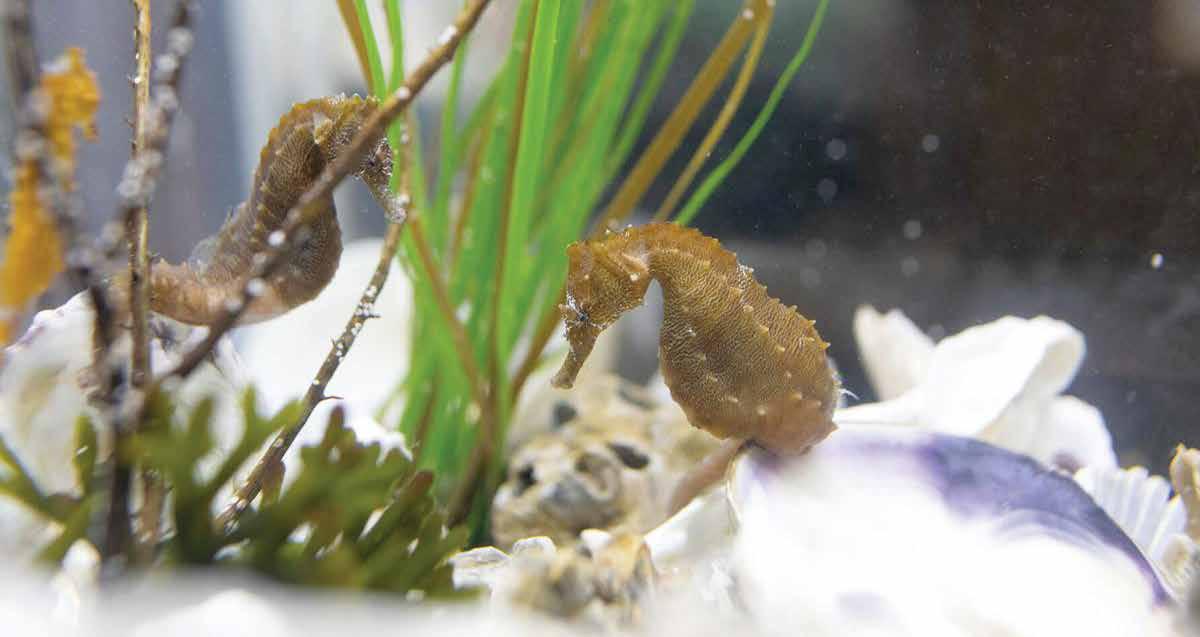
4 minute read
From the Bay
Lined seahorses anchor to underwater plants at the Virginia Living Museum. When mating, the male seahorse incubates 100–300 of the female’s tiny eggs for two weeks. before they hatch. Photo by Will Parson/Chesapeake Bay Program
In the Lower Chesapeake weight of their body “armor” Bay, a small horse moves and their erect habit makes the through the underwater poor swimmers. beds of eelgrass looking They spend most days for food. No, it’s not a pony feeding while attached by their like the famous wild horses tail to vegetation. And when of Assateague Island National they do swim, they use their Seashore. It’s a lined seahorse dorsal fin (which beats 20–30 (Hippocampus erectus), the only times per second) to propel species of seahorse found in the themselves forward, gliding Chesapeake Bay. slightly up and down through
The lined seahorse inhabits a the water. range from the northern point Lined seahorse populations of Nova Scotia, Canada, to the were assessed by the southern area of Venezuela in South America. Locally, lined seahorses are usually found from the Lower to Mid Chesapeake, although in drier, saltier years they may move as far north as Maryland’s Bay Bridge. Seahorses are vertebrate fish belonging to the family Syngnathidae. Other family members include the sea dragon, ghost pipefish, sea moth and pipehorse. The lined seahorse is most closely related to the pipefish: Both share the characteristic elongated tubular lines. The Chesapeake’s underwater grass meadows are the lined seahorse’s preferred habitat. It swims erect, pausing to curl its tail around strands of grass to stabilize its body, then stay very The seahorses’ sophisticated camouflage makes them hard to find, creating a few problems for scientists who want to learn more about the animals. One of the most striking characteristics of this species and transfers nutrients to the developing embryos through a network of capillaries in its pouch. The young remain in the pouch for about two to three weeks, depending on water temperature. A lined seahorse, can change its color, which makes it difficult to find in the wild. Photo by Will Parson/ Chesapeake Bay Program International Union for Conservation of Nature in 2017. It was listed as a vulnerable species because of its proximity to the highly populated coasts of North, Central and South America. Specific worldwide threats include bycatch in shrimp trawl fisheries and collection for the aquarium trade, tourism curios and cultural medicines. In the Chesapeake Bay, their population is considered stable. But the loss of their primary habitat from shoreline jaw with a small toothless still. This skill, combined with is its reproductive cycle. In After a convulsive “birth,” development and nutrimouth at the end. the creature’s ability to quickly many fish species, parental care during which the male ent pollution could harm
A seahorse’s body is covered change its color, camouflaging often falls to the male, which seahorse’s body expels the local populations. Reducing with a kind of bony armor its skin to match the surroundis responsible for fanning or contents of the pouch, tiny nutrient and sediment pollution of jointed rings. A dorsal fin, ings, makes the seahorse an guarding the eggs and making juvenile seahorses emerge. The and conserving our coastal made up of 16–20 rays, beats ambush predator. It uses its sure they remain oxygenated. male usually becomes pregnant shoreline habitats, particularly so rapidly that it appears long, tubular snout to suck in Seahorses takes this a step again almost immediately. underwater grass beds, will help transparent. It also has an anal tiny crustaceans, plankton, further — the males actually Despite the frequency of these ensure the continued existence fin with three or four rays. The worms and other invertebrates guard and nurture the eggs in a pregnancies and the volume of of this unique seahorse of the top of its head, the coronet, is swimming by. pouch on their body. young produced, on average Chesapeake. almost as distinctive in each Effective camouflaging also After an elaborate courtship, only two of the thousands of animal as a human thumbprint. helps to protect the seahorse which the monogamous pair juveniles a pair produces reach Mature lined seahorses can from potential predators such may repeat during a later maturity each breeding season. Kathryn Reshetiloff, a Bay reach a length of 6.7 inches. as ray, fish, birds, crabs and reproductive cycle, the female In summer, the lined Journal columnist, is with the They range in color from pale sea turtles, as well as people, lays 200–300 eggs in the male’s seahorses inhabit the shallower U.S. Fish and Wildlife Service’s yellow to black and are marked who collect them for medipouch before he fertilizes them. areas and swims to water only Chesapeake Bay Field Office in laterally with dusky spots and cines, aquaria or souvenirs. The male provides oxygen a few feet deeper in winter. The Annapolis.











